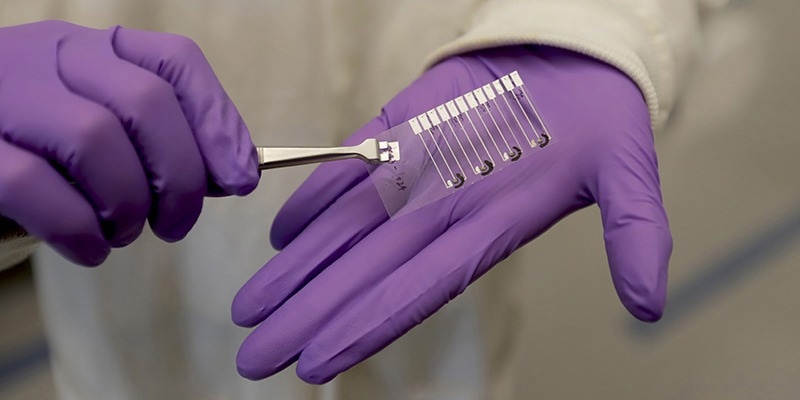The quick and exact measurement of uric acid levels could lead to better diagnosis, therapy, and prediction of many physiological and psychological conditions.
 Researchers in Purdue University’s College of Engineering have created new noninvasive, wearable sensors that monitor levels of uric acid in human sweat. A paper about the research has been published in the peer-reviewed journal Nano Energy. Image Credit: Purdue Research Foundation photo/Jennifer Mayberry
Researchers in Purdue University’s College of Engineering have created new noninvasive, wearable sensors that monitor levels of uric acid in human sweat. A paper about the research has been published in the peer-reviewed journal Nano Energy. Image Credit: Purdue Research Foundation photo/Jennifer Mayberry
Scientists at Purdue University's College of Engineering have created and are advancing noninvasive medical devices to enhance the timeliness and precision of monitoring and treating specific physiological and psychological conditions.
In the words of Wenzhuo Wu, the Ravi and Eleanor Talwar Rising Star Associate Professor of Industrial Engineering, continuous noninvasive tracking of uric acid (UA) levels in human sweat over extended periods has the potential to revolutionize the diagnosis, treatment, and prognosis of various conditions, such as anxiety and hypertension.
My team and I have created new noninvasive, wearable sensors that monitor levels of uric acid in human sweat. These patent-pending sensors, called EPICS, have higher sensitivity and better wearability and can be made from less expensive materials than traditional sensors that measure uric acid levels.
Wenzhuo Wu, Ravi and Eleanor Talwar Rising Star Associate Professor, Industrial Engineering, College of Engineering, Purdue University
A paper about the research has been published in the peer-reviewed journal Nano Energy.
The Impact of Uric Acid
According to Wu, uric acid (UA) is produced in the human body as a byproduct of purine metabolism. Additionally, it serves as a sort of alarm, initiating inflammation as part of the immune response.
“Variation in UA concentration could indicate physiological diseases such as gout, hyperuricemia, and hypertension, as well as psychological conditions such as anxiety and depression. Recent studies report the physiological diseases associated with abnormal UA levels affect approximately 1%-4% of the world’s population and cost more than $20 billion in annual medical expenditures.”
The psychological conditions associated with abnormal UA levels impact 8.74% of the U.S. population and cost $33.7 billion in related medical expenses annually.
Wenzhuo Wu, Ravi and Eleanor Talwar Rising Star Associate Professor, Industrial Engineering, College of Engineering, Purdue University
Drawbacks Of Traditional Uric Acid Monitoring
Wu explains that there are well-equipped clinical measures of UA levels in the blood for metabolism and nutrition control. He also says they have drawbacks.
The intrusive nature of collecting blood and the delay between sample collection and analysis are major hindrances, especially to personalized remote treatments like flare-up prevention and just-in-time nutrition control. Monitoring UA levels in sweat samples has the advantages of being noninvasive and offering real-time results.
Wenzhuo Wu, Ravi and Eleanor Talwar Rising Star Associate Professor, Industrial Engineering, College of Engineering, Purdue University
Wu pointed out that existing wearable sensors designed for measuring UA levels in sweat come with various limitations, such as intricate fabrication processes, the need for sophisticated instruments, costly raw materials, and subpar performance.
“The UA levels in the sweat of a healthy human are significantly lower than the UA levels in the blood. This means sensors must have superior limits of detection. Additionally, continuous monitoring requires intimate contact between the UA sensor and human skin, which imposes further requirements for the wearability of the sensors,” Wenzhuo Wu added.
Purdue EPICS Sensors
Wu and his group have established EPICS, which are flexible and noninvasive sensors that screen uric acid in human sweat. They made the sensors using zinc oxide, a nontoxic, biocompatible, and electrochemically active material.
Wu notes, “Our design allows the possibility of noninvasive monitoring of UA with a boosted performance by otherwise wasted mechanical energy, such as that from the human body. The fundamental piezo-electrocatalytic principles can also be extended to other piezoelectric materials with catalytic properties for high-performance sensing in the biomedical, pharmaceutical, and agricultural areas.”
Wu and his team have been conducting tests on EPICS at Purdue University's Flex Lab since the summer of 2021. According to him, the results indicate that EPICS surpassed traditional UA sensors in the conducted tests.
Wu added, “We demonstrated that the EPICS devices achieve a fourfold enhancement in the UA sensing performance with a small compressive strain boosted by piezo-electrocatalysis during the electrochemical oxidation of UA on the surfaces of mechanically deformed zinc oxide nanorods. The EPICS devices exhibited a superior sensitivity and limit of detection outperforming all reported flexible electrochemical UA sensors.”
Wu and the research team plan to carry out further testing to validate the on-body sensing capabilities of EPICS and assess the sensor's performance over an extended period.
Wu shared details of the sensor innovation with the Purdue Innovates Office of Technology Commercialization, which has filed for a patent to safeguard the intellectual property.
Journal Reference:
Jiang, J., et al. (2023). Flexible piezo-electrocatalytic uric acid sensor. Science Direct. doi.org/10.1016/j.nanoen.2023.108978